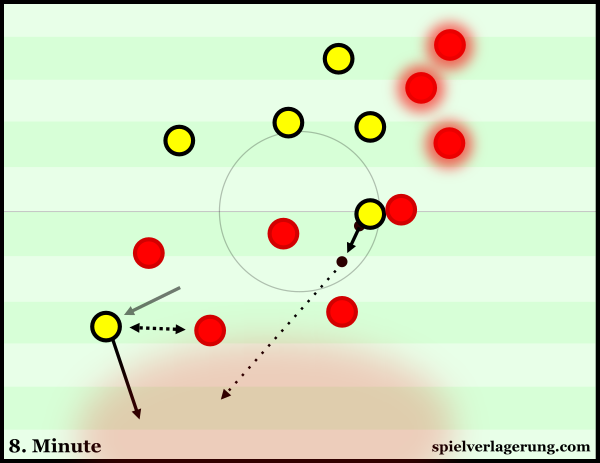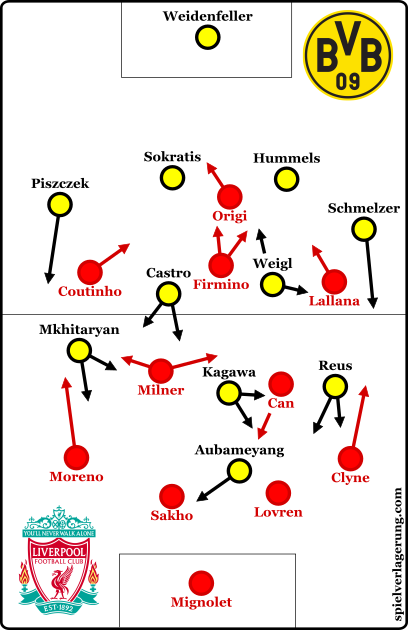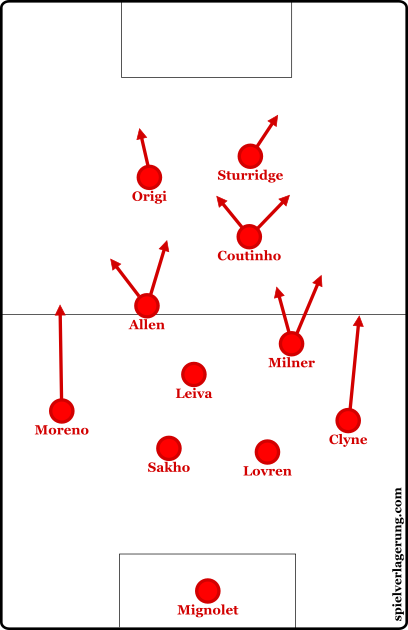Liverpool – Dortmund 4:3 (5:4)
After a tense first leg, both teams faced up at Anfield in a much greater attacking focus and the result was a more chaotic game. It was decided by intelligent changes from Klopp in the second half as he produced another miracle, yet this time from the opposite dugout.
Formational Changes
It was interesting two see changes in shape from both dugouts after the stalemate in Germany. The most surprising adaption came from Tuchel, who abandoned the 3-chain which we saw in the first leg as he opted for a much more orthodox 4-2-3-1 shape; one similar to what we saw throughout the hindrunde. Piszczek moved into a more standard full-back role whilst Castro joined Weigl as a double pivot. Kagawa came into the 10 position and was headed by the attack of Reus, Mkhitaryan and Aubameyang.
Klopp also moved away from his 4-3-2-1 shape used in the first clash and opted for a similar 4-2-3-1 shape. Roberto Firmino came into the aside in place of Jordan Henderson as he moved to a position on the right side of the attack. Being back at Anfield, this was immediately a more attacking set-up from the now-hosts as they looked to create better support around Origi who was often isolated in the first leg with Liverpool’s direct ‘smash-and-grab’ game.
Tuchel’s Defensive Shift
Another big change from the last match was Tuchel’s defensive strategy as his team now defended in not only a largely different shape, but in a significantly lower block too. During Liverpool’s construction they were more passive and there were many less attempts to actively create defensive access (an ability to press the ball effectively) when there wasn’t any before.
With the change of shape, Dortmund dropped into what was between a 4-4-2 and a 4-4-1-1 based on the positioning of Shinji Kagawa. The two forwards were primarily passive and would cover any passing angles into the Liverpool pivot with their cover shadows. On the occasions they would move up, it would only when defensive security was sufficient and the rest of the block rarely followed higher.
Through a deeper-situated defence, Dortmund ended up winning back possession in deeper positions and therefore often had greater space to counter-attack into. During offensive transition, they worked to exploit the problems Liverpool caused themselves through their weak shape and broke well through the centre.

Liverpool’s structure before losing the ball for the first goal. Counterpressing is near-impossible.
This change was ultimately successful, or at least in the opening stages of the game, as Dortmund put themselves into an early 2-0 lead. Both goals came from regains in deep positions followed by fast counter-attacks with the attacking quartet playing a large role in both.
The first came after an attack inside Dortmund’s third broke down with a misplaced pass on the wing. Liverpool were very poorly structured to form any counterpress and Dortmund were able to break quickly towards the opposition goal.

Reus beats a succession of defenders and opens space to play the through-ball to Aubameyang for the 2-0.
In the second, Liverpool’s structure was improved but still quite weak with particularly poor vertical staggering. The breakthrough came more from some strong dribbling by Reus who was then able to thread Aubameyang through into space behind, after the Gabonese forward initially had moved away to create a separation from Sakho on his blind-side.
Liverpool Exploit Compactness Issues
In comparison to the first leg, Liverpool’s attacking ability improved by some distance as a result of Klopp’s adaptions as well as some deficiencies in the German shape.
Defending in their 4-4-2 formation, Dortmund possessed some issues with compactness when they were without the ball and were particularly stretched horizontally. This was to some extent influenced by the orientation of the two wide midfielders as both Mkhitaryan and Reus were situationally oriented to the respective Liverpool full-backs. The result of this was quite a poor coverage of the half-spaces during these moments and Dortmund’s control of the three central columns was lacking. Although their coverage of the full-back was not as tight as you see in most teams, it created somewhat of a disconnect between the winger and his ball-near 8 at times which gave Liverpool opportunity to take advantage.
When the wingers weren’t focused on covering a wider player, Tuchel’s side still had some issues in spatial coverage which stemmed more from weak staggering of the midfield as well as a similar level of low compactness across the whole block. Aside from the orientation of the wingers, the man-oriented nature of Weigl and Castro was also momentarily problematic for Dortmund when faced with Liverpool’s central trio.
In their own right however, Liverpool were much stronger with the ball than the first leg. Away in Dortmund, Klopp took on much more of a ‘smash-and-grab’ strategy and looked to disrupt Dortmund’s defence through numerous long balls to Origi – something which ultimately payed off as the Belgian striker opened the scoring.
Back at home, their attack was much more multi-faceted and their now-occasional direct game was complemented with better ball circulation on the floor too. The formational change supported Liverpool’s attempts too as they benefited from better occupation of the attacking midfield zone with improved spacing across the attack. Their extra attacking midfielder was important in Liverpool progressing the ball between the Dortmund lines and they were more often able to find the ball behind the pairing of Weigl and Castro, often in the half-spaces which were left unprotected as I mentioned above.
Although their possession was often somewhat restricted to the flanks against Dortmund’s 4-4-2, Liverpool spaced the wings quite well and with situational overloads through the movements of the ‘3’ were able to move the ball back inside through the half-spaces. Their attacking shape commonly allowed at least 2 forwards to shift over to the ball-near half-space and with the support of a full-back and ball-near 8
Dortmund’s Improved Attack
Dortmund themselves were also better in possession with the switch to a 4-2-3-1 helping their cause at Anfield. The issues they faced with the defensive line in the first leg were no longer in effect and they had greater presences in higher zones too. With Weigl now supported by Castro in the first line of midfield, Tuchel’s side were more able to progress the ball out of the build-up phase with stronger overloads being created around the Liverpool press.
Their biggest improvement came in the higher areas where the introduction of Kagawa in place of Durm resulted in a more dynamic attack based around breaking through the left of the pitch. The Japanese 10 frequently moved towards the left where he could combine with Reus and Schmelzer whilst Castro moved forward into the centre from a deeper position. Dortmund were able to focus their attacks around particular spaces and their capacity to structure themselves for combinations was improved too.
Moved out to a position on the right, Mkhitaryan was isolated at times but dealt better with this role than in previous performances. He frequently moved inside towards the centre where he could act as a free man and occupy spaces which Kagawa left whilst when he was in possession on the right he was more successful in dribbles whilst his capacity to keep the ball helped too.
Whilst Liverpool’s change of shape gave them better presence in the half-spaces, their own protection of the same areas was decreased in defence. The ‘2’ of Milner and Can were unable to cover the midfield as widely as they had done with Henderson last week and Milner’s tendencies to man-mark out of possession often left his teammate stranded in deeper positions. Whilst their horizontal compactness in midfield had been such an important factor in their defensive stability in Dortmund, they were much more stretched last night and Dortmund had greater success between the lines.
Klopp’s Changes and Dortmund’s Loss of Control
After the interval, the game became much more hectic as Klopp’s side looked to cause a more chaotic game which, at 0-2, would give them a good chance to get back into the game. Tuchel’s Dortmund are a team which depends largely on control of the game and tempo in possession of the ball with their philosophy on positional play. When they don’t have control over the rhythm, they tend to struggle quite significantly with and without possession of the ball.
In possession of the ball, Liverpool’s midfield became significantly narrower with smaller distances between the forwards whilst Milner was given even more licence to take up advanced positions off of the ball. This adaption gave the hosts greater presence in attack and disrupted the stability of the game with their greater attacking focus which made both teams less secure in defence. In chase of the game, the intensity of their pressing also became greater and Dortmund’s already-limited ability to construct possession from deep became even more restrained.
Just after the game moved into the final 30 minutes, Klopp made a clearer change as Liverpool moved into a loose 4-2-2-2 shape through the introduction of Sturridge and Allen. Milner and Can (later Leiva) acted in the first line of midfield whilst Allen and Coutinho played extremely attacking roles higher up. Daniel Sturridge came into the game and played high alongside Divock Origi.
The result of these substitutions was an extremely attacking formation which created large numbers in attacking areas. Liverpool tempo in possession increased massively and looked to use this increased presence in attack to use combinations through the centre of the pitch and have better success when they took a direct approach. The impact was almost immediate as a fast exchange of passes in the 65th minute resulted in a Coutinho shot which beat Weidenfeller’s left hand to make it 3-4 on aggregate.
Klopp changed shape in the 62nd for greater presence in the central attacks allowing for better combinations #lfc pic.twitter.com/UrAFEdoica
— Tom Payne (@TomPayneftbl) April 15, 2016
With an overload of players in the attacking zones, destabilised much of the remaining order in the game and played extremely vertical as they looked to constantly attack the Dortmund box. The German side’s already-weak control was progressively diminishing as the second half wore on and their defence simply didn’t cope against the strong offensive pressure from Klopp’s team.
Tuchel’s reaction to the game’s rhythm changes was quite poor and also had a part to play in the final result. In reaction to Liverpool’s heightened attacking focus, Dortmund sat deeper and deeper and placed little pressure on the opposition in deeper spaces. The hosts dominated the counterpressing and could restart many attacks immediately after a clearance whilst Dortmund’s ability to maintain possession was nowhere to be seen against opposition pressing.
The switch to a 5-man defensive line only emphasised the issues Dortmund previously had and the introduction of Gündogan was far too late as by that time, Liverpool were completely in control of the match. His decision to replace Kagawa for Ginter to achieve greater defensive presence immediately backfired too, as they conceded from corner to the front post where Kagawa had intercepted every single one previously.
Conclusion
In summary, Klopp’s strong tactical changes in the second half inspired a complete turnaround in the game. He deprived Dortmund of the one thing they require most and the rhythm of the game changed entirely. The switch to increase attacking presence created significant pressure on the Dortmund defence until a cleverly-worked deep free-kick resulted in Lovren winning the quarter-final tie for the hosts.




Keine Kommentare vorhanden Alle anzeigen